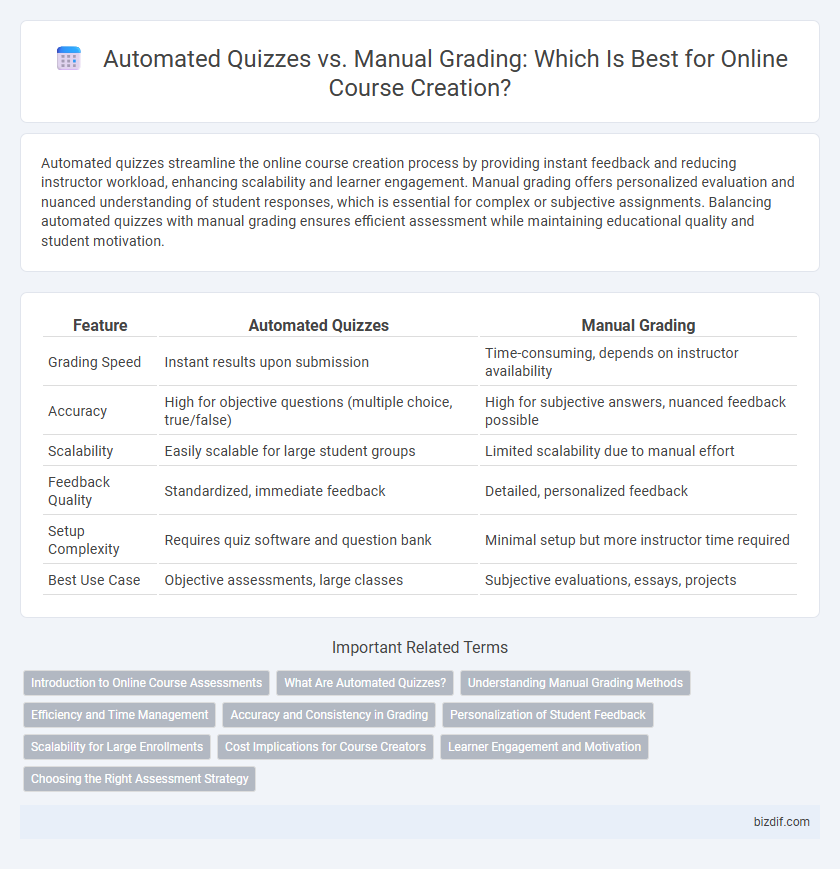Automated quizzes streamline the online course creation process by providing instant feedback and reducing instructor workload, enhancing scalability and learner engagement. Manual grading offers personalized evaluation and nuanced understanding of student responses, which is essential for complex or subjective assignments. Balancing automated quizzes with manual grading ensures efficient assessment while maintaining educational quality and student motivation.
Table of Comparison
| Feature | Automated Quizzes | Manual Grading |
|---|---|---|
| Grading Speed | Instant results upon submission | Time-consuming, depends on instructor availability |
| Accuracy | High for objective questions (multiple choice, true/false) | High for subjective answers, nuanced feedback possible |
| Scalability | Easily scalable for large student groups | Limited scalability due to manual effort |
| Feedback Quality | Standardized, immediate feedback | Detailed, personalized feedback |
| Setup Complexity | Requires quiz software and question bank | Minimal setup but more instructor time required |
| Best Use Case | Objective assessments, large classes | Subjective evaluations, essays, projects |
Introduction to Online Course Assessments
Automated quizzes in online course assessments offer instant feedback and scalable grading, enhancing learner engagement and efficiency. Manual grading provides personalized evaluation, enabling instructors to assess complex responses and provide detailed feedback. Combining both methods optimizes the accuracy and effectiveness of student assessments in digital learning environments.
What Are Automated Quizzes?
Automated quizzes are computer-generated assessments that use algorithms to instantly grade student responses, ensuring rapid feedback and consistent evaluation. These quizzes support multiple question formats such as multiple-choice, true/false, and fill-in-the-blank, enhancing engagement and facilitating scalable assessment in online courses. Automated quizzes reduce instructor workload while maintaining accuracy, making them essential tools for efficient online course creation and management.
Understanding Manual Grading Methods
Manual grading methods in online course creation involve instructors evaluating student responses individually, allowing for nuanced feedback and assessment of complex answers. This approach supports personalized learning by addressing specific misconceptions and tailoring guidance based on the student's performance. Though time-intensive, manual grading enhances the accuracy and depth of evaluation compared to automated quizzes that primarily rely on predefined answer patterns.
Efficiency and Time Management
Automated quizzes significantly enhance efficiency by providing instant feedback and reducing the time instructors spend on grading tasks. Manual grading, while allowing for personalized evaluation and nuanced feedback, demands considerable time and effort, often slowing down course progression. Integrating automated quizzes in online course creation streamlines time management, enabling educators to allocate more focus to course development and student engagement.
Accuracy and Consistency in Grading
Automated quizzes provide consistent grading by eliminating human error and bias, ensuring uniform evaluation across all submissions. Manual grading allows for nuanced assessment but can introduce variability and decrease accuracy due to subjective judgment and fatigue. Leveraging automated systems enhances grading precision and reliability, critical for large-scale online courses.
Personalization of Student Feedback
Automated quizzes provide immediate, consistent feedback by using algorithms that identify common errors, allowing students to quickly adjust their understanding. Manual grading, however, offers personalized, nuanced insights tailored to individual student responses, addressing specific misconceptions and encouraging deeper learning. Combining both methods enhances the personalization of student feedback, improving engagement and learning outcomes in online course creation.
Scalability for Large Enrollments
Automated quizzes offer unparalleled scalability for large enrollments by instantly grading thousands of responses, significantly reducing instructor workload and turnaround time. Manual grading becomes impractical with growing class sizes due to time constraints and inconsistent evaluation standards. Implementing automated assessment tools enhances learning efficiency and maintains consistent grading quality across massive online courses.
Cost Implications for Course Creators
Automated quizzes significantly reduce grading time and labor costs for online course creators by instantly evaluating student responses with minimal human intervention. Manual grading, while potentially more thorough, demands extensive instructor time and increases operational expenses, especially in large classes. Investing in automated assessment tools boosts scalability and cost-efficiency, enabling course creators to allocate resources toward content development and student engagement.
Learner Engagement and Motivation
Automated quizzes provide instant feedback, boosting learner engagement by allowing immediate correction and reinforcement of concepts. Manual grading offers personalized insights and detailed comments, enhancing motivation through tailored support and encouragement. Balancing both methods can optimize learner motivation and maintain consistent engagement in online course environments.
Choosing the Right Assessment Strategy
Selecting the right assessment strategy in online course creation involves weighing the efficiency of automated quizzes against the personalized feedback offered by manual grading. Automated quizzes provide instant results and scalability, ideal for large cohorts or formative assessments, while manual grading ensures nuanced evaluation and deeper insight into student understanding. Balancing these approaches enhances learning outcomes by combining speed with detailed, individualized feedback.
Automated quizzes vs Manual grading Infographic

 bizdif.com
bizdif.com